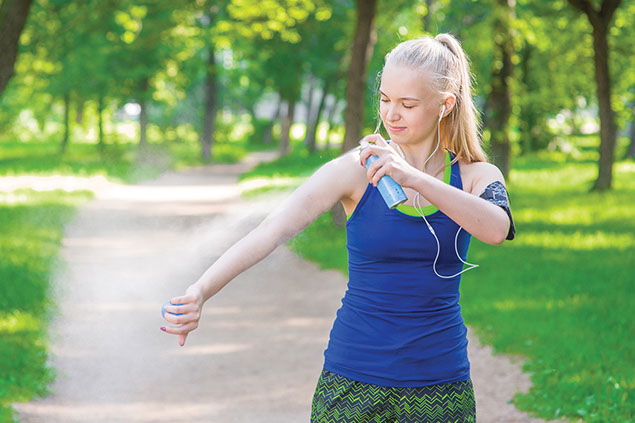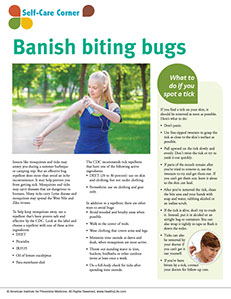SYMPTOM CHECKER
CONDITIONS
Male
Female
Child
Arm, Hand & Shoulder Concerns
Legs & Feet Concerns
Dental & Mouth Concerns
Ear & Nose
Eye Conditions
Head Conditions
Arm, Hand & Shoulder Concerns
Legs & Feet Concerns
Front
Back
Arm, Hand & Shoulder Concerns
Dental & Mouth Concerns
Ear & Nose
Eye Conditions
Head Conditions
Arm, Hand & Shoulder Concerns
Dental & Mouth Concerns
Ear & Nose
Eye Conditions
Head Conditions
Front
Back
Arm, Hand & Shoulder Concerns
Neck Links
Head & Neck Concerns
Arm, Hand & Shoulder Concerns
Neck Links
Head & Neck Concerns
Front
Back
Online Clinic
Wise Healthcare
Banish biting bugs

Print on Demand
Insects like mosquitoes and ticks may annoy you during a summer barbeque or camping trip. But an effective bug repellent does more than avoid an itchy inconvenience. It may help prevent you from getting sick. Mosquitoes and ticks may carry diseases that are dangerous to humans. Many ticks carry Lyme disease and mosquitoes may spread the West Nile and Zika viruses.
To help keep mosquitoes away, use a repellent that’s been proven safe and effective by the CDC. Look at the label and choose a repellent with one of these active ingredients:
• DEET
• Picaridin
• IR3535
• Oil of lemon eucalyptus
• Para-menthane-diol
The CDC recommends tick repellents that have one of the following active ingredients:
• DEET (20 to 30 percent): use on skin and clothing, but not under clothing.
• Permethrin: use on clothing and gear only.
In addition to a repellent, there are other ways to avoid bugs:
• Avoid wooded and brushy areas when possible.
• Walk in the center of trails.
• Wear clothing that covers arms and legs.
• Minimize time outside at dawn and dusk, when mosquitoes are most active.
• Throw out standing water in tires, buckets, birdbaths or other outdoor items at least once a week.
• Do a full-body check for ticks after spending time outside.
What to do if you spot a tick
If you find a tick on your skin, it should be removed as soon as possible. Here’s what to do:
• Don’t panic.
• Use fine-tipped tweezers to grasp the tick as close to the skin's surface as possible.
• Pull upward on the tick slowly and evenly. Don't twist the tick or try to yank it out quickly.
• If parts of the mouth remain after you’ve tried to remove it, use the tweezers to try and get them out. If you can’t get them out, leave it alone so the skin can heal.
• After you’ve removed the tick, clean the bite area and your hands with soap and water, rubbing alcohol or an iodine scrub.
• If the tick is alive, don’t try to crush it. Instead, put it in alcohol or an airtight bag or container. You can also wrap it tightly in tape or flush it down the toilet.
• Ticks can also be removed by your doctor if you can’t get it out yourself.
• If you’ve been bitten by a tick, contact your doctor for follow-up care.
This website is not meant to substitute for expert medical advice or treatment. Follow your doctor’s or health care provider’s advice if it differs from what is given in this guide.
The American Institute for Preventive Medicine (AIPM) is not responsible for the availability or content of external sites, nor does AIPM endorse them. Also, it is the responsibility of the user to examine the copyright and licensing restrictions of external pages and to secure all necessary permission.
The content on this website is proprietary. You may not modify, copy, reproduce, republish, upload, post, transmit, or distribute, in any manner, the material on the website without the written permission of AIPM.
2021 © American Institute for Preventive Medicine - All Rights Reserved. Disclaimer | www.HealthyLife.com















































